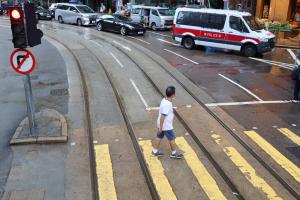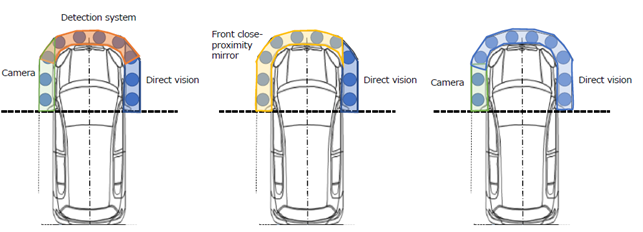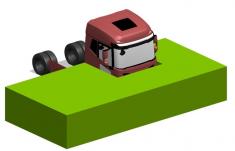
The limited ability of drivers to detect and see correctly pedestrians in close proximity of their vehicle is a key cause of accidents, both for cars and light vehicles, and for heavy duty vehicles. Two new UN regulations adopted recently by UNECE’s World Forum for the Harmonization of Vehicle Regulations (WP.29) to address this issue will significantly increase the safety of vulnerable road users.
“The newly adopted regulations will increase drivers’ capacity to detect pedestrians before the vehicle starts from standstill or while it maneuvers at low speed, and will thus help save lives in many countries,” said Antonio Erario, Chair of WP.29.
Both regulations are due to enter into force by June 2023.
Regulation on awareness of vulnerable road users for passenger cars and light trucks
Drivers cannot fully see all areas around passenger cars and light trucks by looking through the windows or in conventional mirrors. This is especially the case when the vehicle is moving off from a stationary position or going straight at low speed (below 20km/h).
In Japan, for instance, pedestrians account for 35.6% of such fatalities. Passenger cars and small trucks contribute to more than half of the total fatalities and injuries among pedestrians at low-speed manoeuvres.
The new regulation introduces provisions for enhancing driver’s awareness of vulnerable road users at the front and sides of the vehicles through the use of devices, such as additional conventional mirrors, front and lateral view camera systems or detection systems.
It will apply to all passenger cars comprising not more than nine passengers and new trucks not exceeding 3.5 tonnes. Once in force, manufacturers will have the possibility to also request type approval against this regulation for any vehicle, for example, buses, coaches and heavier trucks.
Japan has indicated it will apply this UN regulation.

Sample of compliance options for new regulation: Allows for technology neutral approach
Regulation on driver’s direct vision for large and heavy vehicles
When it comes to large and heavy vehicles, the high position of the driver leads to an even wider blind-spot area and poor direct vision around the front and side of the vehicle.
In Great Britain and Germany such casualties occur predominantly in dense urban areas. Some 57% of British pedestrian and cyclist fatalities result from collisions involving heavy good vehicles in five major cities, representing 25% of the population. In London alone, 37% of such fatalities take place, affecting 15% of the British population. 97% of the fatalities occur on urban roads.
The European Union and Japan have indicated that they will apply this UN Regulation.
The new UN regulation aims to reduce to the greatest possible extent the blind spots at the front and lateral sides of the vehicle that exist in the transition zone between the area covered by conventional mirrors or by front and lateral view camera systems, and the area seen by the driver’s direct vision. This is achieved by setting a minimum visible volumetric space around the front of the vehicle. This method is new within UN regulations and provides more flexibility for the industry to innovate in their provision of the minimum required view.


Volumetric assessment method: Assessment volume (left side) and visible volume (right side) for a left-hand-drive vehicle
The left picture shows the assessment volume with a ground floor area, which is based on indirect fields of vision as regulated for heavy vehicles in Regulation No. 46, extended with two meters on the driver’s side. The height of the volume is determined by the shoulder height of the tallest European population. From this assessment volume, the invisible part from the driver’s eye perspective is subtracted. The right picture shows an example of the volume that remains visible from the driver’s point of view after subtracting the invisible part. The new direct vision regulation now regulates the minimum visible volumes required for different vehicle configurations that are typical or commonly used for urban, construction and long-distance applications.
The two newly adopted regulations build on the UN provisions on blind spots and low-speed manoeuvres that involve collisions of heavy trucks and buses with pedestrians and cyclists, adopted in June 2021 and in October 2018.
The Working Party on General Safety Provisions (GRSG) of WP.29, which prepared the new regulations, will continue to examine how to further increase the protection of vulnerable road users.
Download the new regulations here:
https://unece.org/sites/default/files/2022-09/ECE_TRANS_WP.29_2022_139E.pdf
https://unece.org/sites/default/files/2022-10/ECE_TRANS_WP.29_2022_140r1e.pdf
Note to editors
About the World Forum for Harmonization of Vehicle Regulations
The World Forum for Harmonization of Vehicle Regulations (WP.29), hosted by UNECE, is a unique global platform responsible for the regulatory frameworks regarding the safety and environmental performance of vehicles, their subsystems and parts.
The World Forum manages three Global Agreements on vehicles: 1958 Agreement (UN Regulations); 1998 Agreement (UN Global Technical Regulations); and 1997 Agreement (UN Rules on Periodic Technical Inspections). Any country that is member of the United Nations may participate in the activities of the World Forum and accede to the agreements.
For more information on UNECE’s Vehicle Regulations, please visit: https://www.unece.org/trans/main/welcwp29.html

